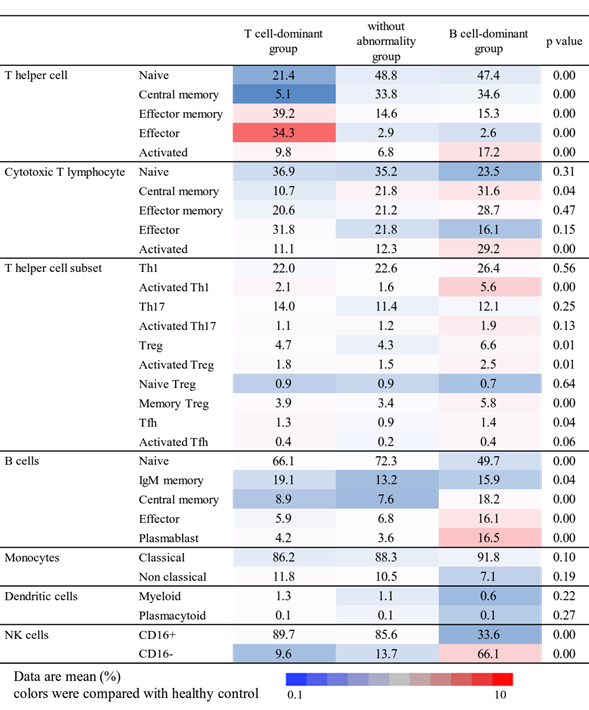Session Information
Date: Sunday, November 5, 2017
Session Type: ACR Poster Session A
Session Time: 9:00AM-11:00AM
The immunophenotyping of peripheral blood associates with nailfold microvascular changes in patients with systemic sclerosis
Background/Purpose: Systemic sclerosis (SSc) is a complex disease with autoimmunity and vasculopathy, leading to subsequent fibrosis. However, little is known about the relationship between immunological abnormality and microvascular changes. Here, we stratified SSc patients based on peripheral immunophenotyping and investigated the association between immunophenotyping and vasculopathy in SSc.
Methods: Ninety patients with SSc were enrolled in this study. Nailfold videocapillaroscopy was performed for qualitative assessment of morphological microvascular. Peripheral blood mononuclear cells were obtained and the phenotype of circulating B, T, NK and dendritic cells was defined based on flow cytometric analysis for human immune system termed "the Human Immunology Project". Based on these results, SSc patients were classified into subgroups by cluster analysis.
Results: The proportion of effector T cell was higher in SSc than the healthy control. The proportion of activated Th1 (2.0% vs 1.3%) and activated Th17 (1.2% vs 0.8%), but not Treg and Tfh, was higher in SSc. On the other hand, the abnormalities of B cell differentiation in SSc patients were mild. The proportion of plasmablast was comparable and that of naïve B cell was higher in SSc. However, cluster analysis stratified SSc patients into three subgroups (Figure): patients who showed almost normal immunophenotype (without abnormality group), patients with high percentage of effector T cell and Th17 cells (T cell-dominant group), and patients with high proportion of plasmablast and effector B cell (B cell-dominant group). The majority (81%) of SSc patients belonged to the without abnormality group. In contrast, the percentage of patients who had severe microvascular changes was highest among the T cell-dominant group and the B cell-dominant group.
Conclusion: Immune abnormality in peripheral blood was not necessarily found in all cases of SSc. However, our data indicated that there are two types of immunological abnormalities associated with the risk of vasculopathy in patients with SSc. Accumulation of further evidence will not only contribute to elucidate the pathogenesis of SSc but also help the development of targeted therapy.
Figure. Immune cell characteristics based on statistical cluster analysis in patients with systemic sclerosis: Immunophenotypes of the three groups. P values by one-way analysis of variance.
To cite this abstract in AMA style:
Kubo S, Nakayamada S, Yoshikawa M, Miyazaki Y, Yoshinari H, Satoh Y, Todoroki Y, Nakano K, Iwata S, Hanami K, Fukuyo S, Miyagawa I, Satoh M, Tanaka Y. The Immunophenotyping of Peripheral Blood Associates with Nailfold Microvascular Changes in Patients with Systemic Sclerosis [abstract]. Arthritis Rheumatol. 2017; 69 (suppl 10). https://acrabstracts.org/abstract/the-immunophenotyping-of-peripheral-blood-associates-with-nailfold-microvascular-changes-in-patients-with-systemic-sclerosis/. Accessed .« Back to 2017 ACR/ARHP Annual Meeting
ACR Meeting Abstracts - https://acrabstracts.org/abstract/the-immunophenotyping-of-peripheral-blood-associates-with-nailfold-microvascular-changes-in-patients-with-systemic-sclerosis/

